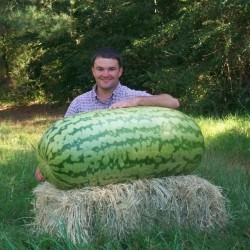Menu
-
MenuBack
- Home
-
Categories
-
-
Categories
-
Vegetable Seeds
-
Varieties by Country
- Varieties from Armenia
- Varieties from BiH
- Varieties from Croatia
- Varieties from France
- Varieties from Germany
- Varieties from Greece
- Varieties from Hungary
- Varieties from India
- Varieties from Italy
- Varieties from Japan
- Varieties from North Macedonia
- Varieties from Peru
- Varieties from Russia
- Varieties from Serbia
- Varieties from Slovenia
- Varieties from Spain
- Varieties from Thailand
- Varieties from Turkey
- Varieties from USA
- Tomato Seeds
- Corn Seeds
- Gourd family
- Bean family
- Cucumber Seeds
- Pepper Seeds
- Carrot family
- Onion family
- Lettuce Seeds
- Potato family
- Cabbage family
- Radish Seeds
- Beetroot family
- Watermelon Seeds
- Melon Seeds
- Cauliflower Seeds
- Sunflower family
-
Varieties by Country
- Fruit Seeds
- Chili - Habanero Seeds
- Medicinal Herb Seeds
- Climbing Plants Seeds
- Trees Bonsai Seeds
- Palm Seeds
- Ornamental Grasses Seeds
- Tobacco Seeds
-
Vegetable Seeds
-
-
-
-
- NEW PRODUCTS
- Create account
- Delivery - Payment
- FAQ
Last Product Reviews
Out of the two seeds, one germinated and the other one was dead and floatin...
By
 Riikka H on 07/03/2024
Riikka H on 07/03/2024
Verified Purchase
There are 389 products.
Showing 361-375 of 389 item(s)

Variety from Greece

Plant resistant to cold and frost
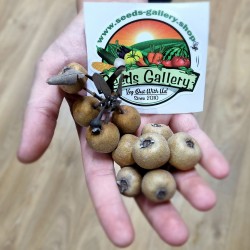
Wild Pear, Almond-leaved...
Price
€2.15
(SKU: V 114)
Seeds Gallery EU,
5/
5
<h2><strong>Wild Pear, Almond-leaved Pear Seeds (Pyrus amygdaliformis)</strong></h2>
<h2><span style="color: #fe0000;"><strong>Price for Package of 5 seeds.</strong></span></h2>
Wild Pear, Almond-leaved Pear (Pyrus amygdaliformis) Is a deciduous shrub or lower tree of the rose family (Rosaceae). It grows up to 6 m in height, the canopy is irregular, round, dense. The root system is strong, deep, and well-branched. The branches are covered with thorns, the bark is reddish, longitudinally, and transversely cracked, about 1 cm thick. Young shoots are brown, initially densely hairy, later bare.<br><br>The buds are small, only about 2 mm long, covered with dark gray to dark brown scales that are finely hairy and pointed. The leaves are alternate, elongated elliptical, 3-8 cm long, 1-3 cm wide, acuminate, entire-edged or finely serrated, dark green on the face, the back is grayish, finely hairy, located on thin petioles about 1-3 cm long.<br><br>The flowers are bisexual, unisexual, about 2 cm in size, clustered 5-12 in clustered inflorescences, the corolla is built of 5 white petals. It blooms in April and May.<br><br>The fruits are round, hard, initially green, later yellow-brown, 2-3 cm in size, located on short stalks. They ripen in October, their seeds are black, flat, about 5-6 mm long.<br><br>It is widespread in southern and southeastern Europe and Asia Minor. We have it along the Adriatic, in Istria, the coast, and Dalmatia. It grows in warm, sunny, and semi-shady places, in thickets, in deciduous forest clearings, in meadows, in the maquis.<br><br>Drought-resistant, weaker to low temperatures, binds the soil well and protects it from erosion. It is slow-growing, it has good shoots from stumps. It is sometimes used as a substrate for grafting fruit trees.<br><br>The fruits are edible, they have a sweet-sour taste. They can be dried and used as a tea or processed as desired.<script src="//cdn.public.n1ed.com/G3OMDFLT/widgets.js"></script>
V 114 (5 S)


Variety from Russia

Plant resistant to cold and frost
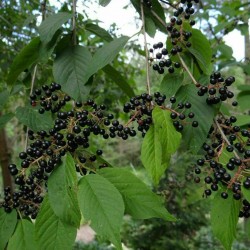
Manchurian cherry Seeds...
Price
€1.85
(SKU: V 193)
Seeds Gallery EU,
5/
5
<h2><strong>Manchurian cherry Seeds (Prunus maackii)</strong></h2>
<h2><span style="color: #fe0000;"><strong>Price for Package of 5 seeds.</strong></span></h2>
Prunus maackii, commonly called the Manchurian cherry or Amur chokecherry, is a species of cherry native to Korea and both banks of the Amur River, in Manchuria in northeastern China, and Amur Oblast and Primorye in southeastern Russia. It used to be considered a species of Prunus subg. Padus, but both morphological and molecular studies indicate it belongs to Prunus subg. Cerasus.<br><br>It is grown as an ornamental tree in northern Europe and North America, mainly for its decorative bark. It prefers sunshine and moist (but drained) soil, and is tolerant of severe winter cold, but not heat. The fruit has been used in the manufacture of juice, jelly, and jam. Specimens in cultivation have been measured to be 17 m tall and 90 cm trunk diameter.<br><br>It is a deciduous tree growing to 4–10 m tall. The bark on young trees is very distinct, smooth, glossy bronze-yellow, but becoming fissured and dull dark grey-brown with age. The leaves are alternate, ovate, 4–8 cm long and 2.8–5 cm broad, with a pubescent 1–1.5 cm petiole, and an entire or very finely serrated margin; they are dark green above, slightly paler, and pubescent on the veins below. The flowers produced on erect spikes 5–7 cm long, each flower 8–10 mm diameter, with five white petals. The fruit is a small cherry-like drupe 5–7 mm diameter, green at first, turning first red then dark purple or black at maturity. Flowering is in mid-spring, with the fruit ripe in early summer to early autumn.<script src="//cdn.public.n1ed.com/G3OMDFLT/widgets.js"></script>
V 193 (5 S)


Plant resistant to cold and frost

Coming Soon
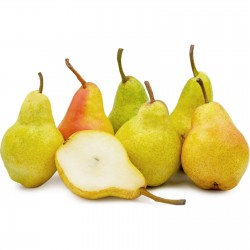
Williams pear seeds
Price
€1.45
(SKU: V 121)
Seeds Gallery EU,
5/
5
<h2><strong>Williams pear seeds</strong></h2>
<h2><span style="color: #fe0000;"><strong>Price for Package of 5 seeds.</strong></span></h2>
Williams pear is one of the most famous and highest quality pear varieties. It is an older variety, originating from Great Britain. William matures in the second half of August. The fruits are very large up to 230g.<br><br>The tree is up to 9 meters high, the flowers are white in William's flower and it blooms in April and May. The basic color of the fruit is light green - which when ripe turns into lemon yellow (varieties that are reddish in color have been developed). Small brown spots (lenticels) can be seen on the epidermis.<br><br>The flesh is fine-grained and very fine in texture, yellowish-white in color, sweet and juicy. It is full of flavor with a specifically recognizable, rather pronounced musky aroma and smell. It can practically be said that people equate the taste of a pear with the taste of William.<br><br>The fruits have a characteristic "pear" shape that resembles a bell. The variety is William's, but there are really many varieties produced from it.<br><br>It is very suitable, both for fresh use and for processing. It begins to bear fruit early and gives birth abundantly. It is harvested 2 weeks before ripening (usually at the end of August and during the month of September) and can be stored in the refrigerator for up to 5 months.<script src="//cdn.public.n1ed.com/G3OMDFLT/widgets.js"></script>
V 121 (5 S)

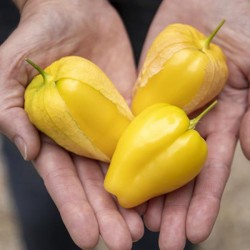
Tomatillo Queen of...
Price
€4.50
(SKU: VT 167)
Seeds Gallery EU,
5/
5
<h2><strong>Tomatillo Queen of Malinalco seeds (Phylasis ixocarpa)</strong></h2>
<h2><span style="color: #fe0000;" class=""><strong>Price for Package of 10 seeds. </strong></span></h2>
An old and very rare variety from the town of Malinalco in southwestern Mexico. The tomatillo is also known as Mexican husk tomato. It is not a tomato like a name suggests, but it is closely related to the pineapple cherry. Like other Tomatillos, the plant has a bushy habit and height of 180 - 200 cm.<br><br>The fruits of the tomatillo are surrounded by a thin Chinese lantern-shaped membrane. This membrane starts out green and turns brown, almost transparent when the fruits are ripe. These fruits ripen from green to light yellow. This tomatillo is larger and sweeter than other tomatillo varieties. <br><br>The taste is an exotic combination of sweet and sour. The shape of this Queen of Malinalco is round and elongated to tapered. The flesh is nice and sweet and juicy. Tomatillos can be used in salads, salsas, and exotic fruit desserts and are also made into compotes.<br><br>Furthermore, chili sauce (Salsa Verde) is made with tomatillos and chilies. Give this plant firm support. Harvesting is possible from August when the lantern becomes translucent and the berry turns yellow. Ripe fruits fall off the plant regularly. Nonhardy annual. <br><br>Sowing in March, transplanting from April at stable temperatures. Ready in a little over two months after transplantation, they are large in size. In particular, this variety is among the sweetest of the species, with an exceptional citrus aftertaste.
<script src="//cdn.public.n1ed.com/G3OMDFLT/widgets.js"></script>
VT 167 (5 S)


Variety from Japan
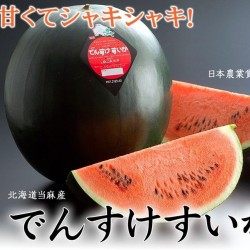
Japan Densuke Watermelon seeds
Price
€4.95
(SKU: V 123)
Seeds Gallery EU,
5/
5
<h2 class=""><strong>Japan Densuke Watermelon seeds</strong></h2>
<h2><span style="color: #ff0000;"><strong>Price for Package of 5, 10, 50 seeds.</strong></span></h2>
<strong>The Worlds Most Expensive Watermelon Fetches Up To $4500!</strong><br>$4500 for a watermelon?! <br>Densuke Watermelons are like the luxury car in the watermelon world. Grown on the island of Hokkaido in Japan and their numbers are limited every year! Densuke Watermelons are the world's most expensive watermelons!<br><br>Densuke watermelons grow in Hokkaido in Japan. The rind on the watermelon is visibly darker and the flesh is known to be much sweeter than the regular watermelons sold elsewhere.<br><br>Experts say that the quality in sweetness and taste is much higher than the other melons in the market and the texture is crunchier. The melons are also limited in numbers which put them in high demand, and high price.
<script src="//cdn.public.n1ed.com/G3OMDFLT/widgets.js"></script>
V 123 (5 S)

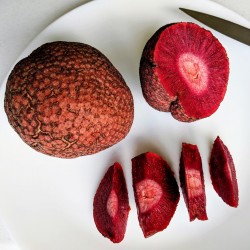
African Peach Seeds...
Price
€2.15
(SKU: V 108)
Seeds Gallery EU,
5/
5
<h2><strong>African Peach Seeds (Nauclea latifolia)</strong></h2>
<h2><span style="color: #ff0000;"><strong>Price for a Package of 10 seeds.</strong></span></h2>
<p>Nauclea is a genus of flowering plants in the family Rubiaceae. The species are evergreen trees or shrubs that are native to tropical Africa, where it grows in lower elevations in the forests of the savannah.</p>
<p>A small to medium-sized tree or shrub, up to 30 m high, with large, simple, conspicuously veined leaves and strange, but beautiful, spherical, strongly scented, white inflorescences. It produces red, edible fruits with juicy, sweet, red, pulp, the taste of which is reminiscent of apples.</p>
<p>In cultivation, it adapts well to tropical climates and begins to produce fruit after just a few years. So far, however, it is largely unknown outside of Africa.</p>
<p>It can be grown in a large flower pot.</p>
V 108 (10 S)

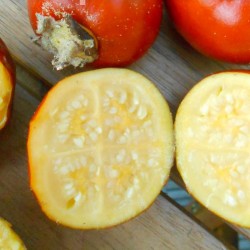
Fuzzyfruit nightshade seeds...
Price
€2.25
(SKU: V 124)
Seeds Gallery EU,
5/
5
<h2><strong>Fuzzyfruit nightshade seeds (Solanum candidum)</strong></h2>
<h2><span style="color: #ff0000;"><strong>Price for Package of 5 seeds.</strong></span></h2>
<p>A herby shrub to 3 m tall with large, lobed leaves and furry, apricot-sized, edible fruits. Solanum candidum is widely distributed in woodlands and disturbed areas from southern Mexico south along the Andes to Peru.</p>
<p>Solanum candidum is a species of evergreen shrub native to South America and occasionally grown for its edible fruit.</p>
<p>Undomesticated and very rare in cultivation, it is known as fuzzyfruit nightshade, naranjilla Silvestre or chichilegua. The fruit somewhat resembles the related Cocona (Solanum sessiliflorum), and Solanum candidum will apparently hybridize with a number of close relatives, including cocona, naranjilla, and pseudolulo. One notable difference is the extremely hirsute fruits, which – unlike most of its relatives – do not detach easily upon full ripening, which is a hindrance to eating the ripe fruit. Nonetheless, S. candidum is a close relative of other nightshades cultivated for their edible fruit, including the tomato (S. lycopersicum), the naranjilla (S. quitoense), and the eggplant (S. melongena). Its relatively strong resistance to pests and disease (in comparison with its more appetizing relatives) has drawn some agricultural interest.</p>
<p>Scientifically, S. candidum is of additional interest, as it appears to be the closest relative and a possible ancestor to Asian members of the same botanical clade, notably Solanum lasiocarpum, which is native to India but is cultivated for its naranjilla-like fruits, and will likewise readily hybridize with S. candidum.</p>
<p>Solanum candidum is presumed to be native to the temperate Andean regions of Colombia, Peru and Chile. Like the cocona, naranjilla, and Indian nightshade, S. candidium can bear fruit within 1 or 2 years from seed. A short-lived perennial, fruit production requires a rather long growing season, which limits its agricultural potential in more temperate climates. Like the naranjilla and cocona, S. candidum is best adapted to subtropical cloud forest climates, where frost is unknown, but extreme heat is likewise very rare or unknown. The fruits are round berries, covered in persistent fur even when ripe, to 2 cm in size, which ripen to yellow or red.</p>
V 124 (5 S)

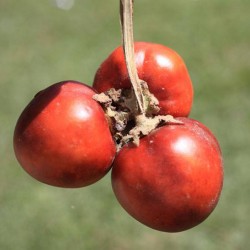
Small Red Cocona Seeds...
Price
€2.35
(SKU: V 132)
Seeds Gallery EU,
5/
5
<h2><strong>Small Red Cocona Seeds (Solanum sessiliflorum)</strong></h2>
<h2><span style="color: #ff0000;"><strong>Price for Package of 5 seeds.</strong></span></h2>
<p>A cultivar of Solanum sessiliflorum with tasty, small, brownish red fruits that is popular in the Amazon lowlands of Colombia and Peru for juicing and sauces.</p>
<p>Solanum sessiliflorum, the cocona, is a tropical shrub of the family Solanaceae. The cocona plant has sturdy branches and huge, serrate and hairy leaves. Cocona closely resembles a number of close relatives, including naranjilla and pseudolulo. It can be distinguished from those plants by its lack of spines. It will hybridize with those and other close relatives. Cocona also lacks the characteristic purple coloring usually seen in the naranjilla. Its flowers resemble large potato flowers, with light green petals. Cocona is harvested in parts of South America around the Amazon rainforest such as Purús Province in eastern Peru.</p>
<p>The fruit of cocona is a red, orange, or yellow edible berry. Cocona is native to the Andean region of South America, where it is occasionally cultivated for human consumption.</p>
<p>Cocona can also be grown as an indoor ornamental plant in temperate climates, but it seems to be quite sensitive to spider mites, so care should be taken not to keep it in too dry air during winter. Like the naranjilla, coconas are highly sensitive to aphids and nematodes. As subtropical plants, they can endure cool weather but will be killed or severely damaged by frost. During summer, it can be grown outside or in a cold greenhouse. When grown from seed, coconas can bear fruit in as little as 9 months, or as long as 24.</p>
<p>Solanum georgicum and Solanum hyporhodium were (and sometimes still are) included in this species, but they are generally treated as distinct today.</p>
V 132 (5 S)

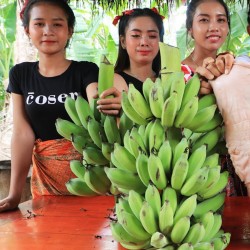
Bornean Hairy Banana Seeds...
Price
€4.25
(SKU: V 88 MH)
Seeds Gallery EU,
5/
5
<h2><strong>Bornean Hairy Banana Seeds (Musa hirta)</strong></h2>
<h2><span style="color: #ff0000;"><strong>Price for Package of 3 seeds.</strong></span></h2>
<p>A little-known banana only about 2.5 m (8 feet) high that forms attractive clumps. The erect inflorescence with hairy stems creates a pointed bud with shiny, purple-pink leaves, followed by small, chunky, golden-hairy fruits.</p>
<p>The fruit, as with only a few other types of bananas, is removed when fully ripe, which means that the peel itself splits and reveals the pulp of the fruit from the inside.</p>
<p>Unlike most bananas, it is more sweet and juicy. Ripe fruit tastes like a mixture of kiwi and banana and the seeds are eaten together with the fruit.</p>
<p>Unripe fruits are peeled and eaten with salt. The flowers are used as vegetables, cooked and seasoned with salt and spices.</p>
<p>This species has ornamental and fruity qualities that should be seriously considered for cultivation.</p>
V 88 MH (3 S)

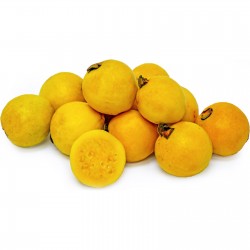
Brazilian Guava Seeds...
Price
€2.50
(SKU: V 179)
Seeds Gallery EU,
5/
5
<h2><strong>Brazilian Guava Seeds (Psidium guineense)</strong></h2>
<h2><span style="color: #ff0000;"><strong>Price for Package of 5 seeds.</strong></span></h2>
<p>Common names include Brazilian guava, Castilian guava, sour guava, Guinea guava (English language), Goyavier du Brésil (French language), brasiliaanse koejawel (Afrikaans), Stachelbeerguave (German language), chobo, diondan (Bolivia), guayabillo de tierra fria (El Salvador), araçá do campo, aracahy (Brazil), guayaba brava, sacha guayaba (Peru), allpa guayaba (Ecuador), guayaba agria (Venezuela, Mexico), guayaba acida, chamach, pichippul (Guatemala), guísaro (Costa Rica), and guayabita de sabana (Panama).</p>
<p>This plant is native to the Americas, where its natural range extends from Mexico to Argentina and includes parts of the Caribbean. It has been widely introduced outside of this range, and it is cultivated in some places. It is naturalized in parts of India.</p>
<p>The plant grows best on sunny sites with moist, fertile soils, but it is tolerant of a wide range of conditions and can grow in disturbed areas and in bad soils. It does not tolerate salinity or flooded substrates. In Brazil, it is most common in coastal areas.</p>
<p>This plant can be a shrub 1 to 3 meters tall or a tree reaching 7 meters. The bark and foliage are grayish. The leaves are up to 14 centimeters long by 8 wide. The stiff, oval-shaped blades sometimes have toothed edges. The undersides are very glandular and are coated in pale or reddish hairs. Flowers grow in the leaf axils, singly or in clusters of up to 3. The flower has a white corolla and many stamens. It is fragrant. The fruit is firm, tasty, aromatic, sweet, juicy, rounded, and up to 2.5 centimeters wide. It has yellow skin, a yellow outer pulp, and whitish inner pulp containing many seeds. It can be eaten fresh or made into jams, drinks, or desserts.</p>
<p>It makes a lovely and robust ornamental and fruit tree for tropical climates.</p>
<p>It can be grown in a flower pot!</p>
V 179 (5 S)


Plant resistant to cold and frost
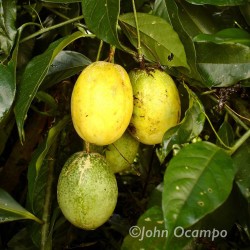
Perfect Passionfruit Seeds...
Price
€3.15
(SKU: V 210)
Seeds Gallery EU,
5/
5
<h2><strong>Perfect Passionfruit Seeds (Passiflora popenovii)</strong></h2>
<h2><span style="color: #ff0000;"><strong>Price for Package of 3 seeds.</strong></span></h2>
<p>The rare Passiflora popenovii gives probably the most delicious fruit of all Passiflora species. The transparent and very juicy flesh inside the soft shell of the bright yellow fruit is extremely sweet and has an exceptional, exotic, and fragrant taste.</p>
<p>It originates from the rainforests of Colombia and Ecuador between 500 and 1900 m (1600 and 6200 feet) but is believed to have become extinct in the wild and to be grown only locally. It will easily adapt to growing in a wide range of climatic conditions.</p>
<p>We think that Perfect Passionfruit has the potential to become far more popular than Passiflora edulis or Passiflora ligularis, which are common in fruit markets around the world.</p>
<p>Cold hardy to -6C</p>
V 210 (3 S)


Plant resistant to cold and frost
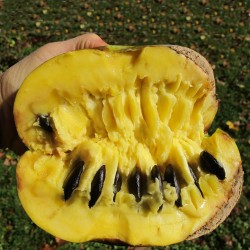
American papaw, pawpaw...
Price
€7.50
(SKU: V 48)
Seeds Gallery EU,
5/
5
<h2><strong>American papaw, pawpaw Seeds (Asimina triloba)</strong></h2>
<h2><span style="color: #fe0000;"><strong>Price for Package of 3 seeds.</strong></span></h2>
<p style="margin: 0.5em 0px; color: #202122; font-family: sans-serif; font-size: 14px; background-color: #ffffff;"><em><strong>Asimina triloba</strong></em>, the <strong>American papaw</strong>, <strong>pawpaw</strong>, <strong>paw paw</strong>, or <strong>paw-paw</strong>, among many regional names, is a small deciduous tree native to the eastern United States and Canada, producing a large, yellowish-green to brown fruit.<sup id="cite_ref-KSUfaq_2-0" class="reference" style="line-height: 1; unicode-bidi: isolate; white-space: nowrap; font-size: 11.2px;">[2]</sup><sup id="cite_ref-ncsu_3-0" class="reference" style="line-height: 1; unicode-bidi: isolate; white-space: nowrap; font-size: 11.2px;">[3]</sup><sup id="cite_ref-layne_4-0" class="reference" style="line-height: 1; unicode-bidi: isolate; white-space: nowrap; font-size: 11.2px;">[4]</sup> It belongs to the genus <em>Asimina</em> in the same plant family (the Annonaceae) as the custard-apple, cherimoya, sweetsop, ylang-ylang, and soursop.</p>
<p style="margin: 0.5em 0px; color: #202122; font-family: sans-serif; font-size: 14px; background-color: #ffffff;">The pawpaw is a patch-forming (clonal) understory tree found in well-drained, deep, fertile bottomland and hilly upland habitat, with large, simple leaves. Pawpaw fruits are the largest edible fruit indigenous to the United States<sup id="cite_ref-purdue_5-0" class="reference" style="line-height: 1; unicode-bidi: isolate; white-space: nowrap; font-size: 11.2px;">[5]</sup> <sup id="cite_ref-6" class="reference" style="line-height: 1; unicode-bidi: isolate; white-space: nowrap; font-size: 11.2px;">[6]</sup>(not counting gourds, which are typically considered vegetables rather than fruit for culinary purposes, although in botany they are classified as fruit).<sup id="cite_ref-KSU_7-0" class="reference" style="line-height: 1; unicode-bidi: isolate; white-space: nowrap; font-size: 11.2px;">[7]</sup></p>
<p style="margin: 0.5em 0px; color: #202122; font-family: sans-serif; font-size: 14px; background-color: #ffffff;">Pawpaw fruits have a sweet, custard-like flavor somewhat similar to banana, mango, and pineapple, and are commonly eaten raw, but are also used to make ice cream and baked desserts. The bark, leaves, and fruit contain the insecticidal neurotoxin, annonacin.</p>
<h2><span id="Names">Names</span></h2>
<p>This plant's scientific name is <em>Asimina triloba.</em> The genus name <em>Asimina</em> is adapted from the Native American (probably Miami-Illinois<sup id="cite_ref-Chamberlain_9-0">[9]</sup>) name <span title="Miami-Illinois-language text"><em>assimin</em></span> or <span title="Miami-Illinois-language text"><em>rassimin</em></span><sup id="cite_ref-Werthner_10-0">[10]</sup> through the French colonial <span title="French-language text"><em>asiminier</em></span>.<sup id="cite_ref-Sargent_11-0">[11]</sup> The specific epithet <em>triloba</em> in the species' scientific name refers to the flowers' three-lobed calyces and doubly three-lobed corollas,<sup id="cite_ref-Werthner_10-1">[10]</sup> the shape not unlike a tricorne hat.</p>
<p>The common name of this species is variously spelled pawpaw, paw paw, paw-paw, and papaw. It probably derives from the Spanish <em>papaya</em>, an American tropical and subtropical fruit (<em>Carica papaya</em>) sometimes also called "papaw",<sup id="cite_ref-12">[12]</sup> perhaps because of the superficial similarity of their fruits and the fact that both have very large leaves. The name pawpaw or papaw, first recorded in print in English in 1598, originally meant the giant herb <em>Carica papaya</em> or its fruit (as it still commonly does in many English-speaking communities, including Australia, New Zealand, and South Africa). Daniel F. Austin's <em>Florida Ethnobotany</em><sup id="cite_ref-13">[13]</sup> states that:</p>
<blockquote>
<p>The original "papaw" ... is <em>Carica papaya</em>. By 1598, English-speaking people in the Caribbean were calling these plants "pawpaws" or "papaws" ... [yet later, when English-speakers settled in] the temperate Americas, they found another tree with a similarly aromatic, sweet fruit. It reminded them of the "papaya", which had already become "papaw", so that is what they called these different plants ... By 1760, the names "papaw" and "pawpaw" were being applied to <em>A. triloba</em>.</p>
</blockquote>
<p>Yet <em>A. triloba</em> has had numerous local common names, many of which compare it to a banana rather than to <em>Carica papaya</em>. These include: wild banana, prairie banana, Indiana banana, Hoosier banana, West Virginia banana, Kansas banana, Kentucky banana, Michigan banana, Missouri banana, Appalachian banana, Ozark banana, Indian banana, banango, and the poor man's banana, as well as American custard apple, <em>asimoya</em>,<sup id="cite_ref-14">[14]</sup> Quaker delight, and hillbilly mango.<sup id="cite_ref-15">[15]</sup></p>
<p>Due to increased interest in the foraging and locavore food movement during the late 2010s and the COVID-19 pandemic,<sup id="cite_ref-16">[16]</sup> the pawpaw has been referred to tongue-in-cheek as the "hipster banana".<sup id="cite_ref-17">[17]</sup></p>
<p>Several tribes of Native Americans have terms for the pawpaw such as <span title="Pawnee-language text"><em>riwahárikstikuc</em></span> (Pawnee),<sup id="cite_ref-18">[18]</sup> <span title="Kansa-language text"><em>tózhaⁿ hu</em></span> (Kansa),<sup id="cite_ref-19">[19]</sup> and <span title="Choctaw-language text"><em>umbi</em></span> (Choctaw).<br /><br /></p>
<h2><span id="Description">Description</span></h2>
<div>
<div><img alt="" src="https://upload.wikimedia.org/wikipedia/commons/thumb/1/17/Asimina_triloba_kz1.jpg/220px-Asimina_triloba_kz1.jpg" decoding="async" width="220" height="212" srcset="//upload.wikimedia.org/wikipedia/commons/thumb/1/17/Asimina_triloba_kz1.jpg/330px-Asimina_triloba_kz1.jpg 1.5x, //upload.wikimedia.org/wikipedia/commons/thumb/1/17/Asimina_triloba_kz1.jpg/440px-Asimina_triloba_kz1.jpg 2x" data-file-width="2568" data-file-height="2472" style="border-width: 1px; border-image-width: initial;" />
<div>
<div></div>
Paw paw blossom</div>
</div>
</div>
<div>
<div><img alt="" src="https://upload.wikimedia.org/wikipedia/commons/thumb/1/15/Paw_Paw_blossom.jpg/220px-Paw_Paw_blossom.jpg" decoding="async" width="220" height="198" srcset="//upload.wikimedia.org/wikipedia/commons/thumb/1/15/Paw_Paw_blossom.jpg/330px-Paw_Paw_blossom.jpg 1.5x, //upload.wikimedia.org/wikipedia/commons/thumb/1/15/Paw_Paw_blossom.jpg/440px-Paw_Paw_blossom.jpg 2x" data-file-width="2117" data-file-height="1905" style="border-width: 1px; border-image-width: initial;" />
<div>
<div></div>
Paw paw blossoms</div>
</div>
</div>
<p><em>A. triloba</em> is a large shrub or small tree growing to a height of 35 ft (11 m), rarely as tall as 45 ft (14 m), with trunks 8–12 in (20–30 cm) or more in diameter. The large leaves of pawpaw trees are clustered symmetrically at the ends of the branches, giving a distinctive imbricated appearance to the tree's foliage.<sup id="cite_ref-Werthner_10-2">[10]</sup><sup id="cite_ref-Keeler_21-0">[21]</sup></p>
<p>The leaves of the species are simple, alternate and spirally arranged, entire, deciduous, obovate-lanceolate, 10–12 in (25–30 cm) long, 4–5 in (10–13 cm) broad, and wedge-shaped at the base, with an acute apex and an entire margin, with the midrib and primary veins prominent. The petioles are short and stout, with a prominent adaxial groove. Stipules are lacking. The expanding leaves are conduplicate, green, covered with rusty tomentum beneath, and hairy above; when fully grown they are smooth, dark green above, and paler beneath. When bruised, the leaves have a disagreeable odor similar to a green bell pepper. In autumn, the leaves are a rusty yellow, allowing pawpaw groves to be spotted from a long distance.<sup id="cite_ref-KSU_7-1">[7]</sup><sup id="cite_ref-Werthner_10-3">[10]</sup><sup id="cite_ref-Keeler_21-1">[21]</sup></p>
<p>Pawpaw flowers are perfect, about 1–2 in (3–5 cm) across, rich red-purple or maroon when mature, with three sepals and six petals. They are borne singly on stout, hairy, axillary peduncles. The flowers are produced in early spring at the same time as or slightly before the new leaves appear, and have a faint fetid or yeasty smell.<sup id="cite_ref-KSU_7-2">[7]</sup><sup id="cite_ref-Werthner_10-4">[10]</sup><sup id="cite_ref-Keeler_21-2">[21]</sup><sup id="cite_ref-Georgia_22-0">[22]</sup></p>
<div>
<div><img alt="" src="https://upload.wikimedia.org/wikipedia/commons/thumb/a/aa/Pawpaw-fruit.jpg/220px-Pawpaw-fruit.jpg" decoding="async" width="220" height="246" srcset="//upload.wikimedia.org/wikipedia/commons/thumb/a/aa/Pawpaw-fruit.jpg/330px-Pawpaw-fruit.jpg 1.5x, //upload.wikimedia.org/wikipedia/commons/a/aa/Pawpaw-fruit.jpg 2x" data-file-width="402" data-file-height="450" style="border-width: 1px; border-image-width: initial;" />
<div>
<div></div>
Fruit</div>
</div>
</div>
<p>The fruit of the pawpaw is a large, yellowish-green to brown berry, 2–6 in (5–15 cm) long and 1–3 in (3–8 cm) broad, weighing from 0.7–18 oz (20–510 g), containing several brown or black seeds <span role="math">1⁄2</span>–1 in (15–25 mm) in diameter embedded in the soft, edible fruit pulp. The conspicuous fruits begin developing after the plants flower; they are initially green, maturing by September or October to yellow or brown. When mature, the heavy fruits bend the weak branches down.<sup id="cite_ref-KSU_7-3">[7]</sup><sup id="cite_ref-Werthner_10-5">[10]</sup><sup id="cite_ref-Keeler_21-3">[21]</sup></p>
<p>Other characteristics:</p>
<ul>
<li>Calyx: Sepals three, valvate in bud, ovate, acuminate, pale green, downy<sup id="cite_ref-Werthner_10-6">[10]</sup><sup id="cite_ref-Keeler_21-4">[21]</sup></li>
<li>Corolla: Petals six, in two rows, imbricate in the bud; inner row acute, erect, nectariferous; outer row broadly ovate, reflexed at maturity; petals at first are green, then brown, and finally become dull purple or maroon and conspicuously veiny<sup id="cite_ref-Werthner_10-7">[10]</sup><sup id="cite_ref-Keeler_21-5">[21]</sup></li>
<li>Stamens: Indefinite, densely packed on the globular receptacle; filaments short; anthers extrorse, two-celled, opening longitudinally<sup id="cite_ref-Keeler_21-6">[21]</sup></li>
<li>Pollen: Shed as permanent tetrads<sup id="cite_ref-23">[23]</sup></li>
<li>Pistils: Several, on the summit of the receptacle, projecting from the mass of stamens; ovary one-celled; stigma sessile; ovules many<sup id="cite_ref-Keeler_21-7">[21]</sup></li>
<li>Branchlets: Light brown, tinged with red, marked by shallow grooves<sup id="cite_ref-Keeler_21-8">[21]</sup></li>
<li>Winter buds: Small, of two kinds, the leaf buds pointed and closely appressed to the twigs, and the flower buds round, brown, and fuzzy<sup id="cite_ref-Werthner_10-8">[10]</sup></li>
<li>Bark: Light gray, sometimes blotched with lighter gray spots, sometimes covered with small excrescences, divided by shallow fissures; inner bark tough, fibrous; bark with a very disagreeable odor when bruised<sup id="cite_ref-Werthner_10-9">[10]</sup><sup id="cite_ref-Keeler_21-9">[21]</sup></li>
<li>Wood: Pale, greenish yellow, sapwood lighter; light, soft, coarse-grained and spongy with a specific gravity of 0.3969 and a density of 24.74 pounds per cubic foot (396.3 kg/m<sup>3</sup>)<sup id="cite_ref-Werthner_10-10">[10]</sup><sup id="cite_ref-Keeler_21-10">[21]</sup></li>
<li>Longevity of fruit production: Undetermined<sup id="cite_ref-Cantaluppi_24-0">[24]</sup></li>
</ul>
<h2><span id="Range_and_ecology">Range and ecology</span></h2>
<div>
<div><img alt="" src="https://upload.wikimedia.org/wikipedia/commons/thumb/4/41/PawPaw_bark.jpg/170px-PawPaw_bark.jpg" decoding="async" width="170" height="256" srcset="//upload.wikimedia.org/wikipedia/commons/thumb/4/41/PawPaw_bark.jpg/255px-PawPaw_bark.jpg 1.5x, //upload.wikimedia.org/wikipedia/commons/thumb/4/41/PawPaw_bark.jpg/340px-PawPaw_bark.jpg 2x" data-file-width="2000" data-file-height="3008" style="border-width: 1px; border-image-width: initial;" />
<div>
<div></div>
Bark</div>
</div>
</div>
<p>The pawpaw is native to the Eastern, Southern, and Midwestern United States and adjacent Ontario, Canada, from New York west to southeastern Nebraska, and south to northern Florida and eastern Texas.<sup id="cite_ref-KSU_7-4">[7]</sup><sup id="cite_ref-FNA_A._triloba_25-0">[25]</sup><sup id="cite_ref-26">[26]</sup></p>
<p>The tree commonly grows in floodplains and shady, rich bottomlands, where it often forms a dense, clonally spreading undergrowth in the forest, often appearing as a patch or thicket of individual, small, slender trees. Pawpaws are not the first to colonize a disturbed site (arriving roughly four years after a clearcut), but may become dominant and slow the establishment of oaks and hickories. Although shade-tolerant, pawpaws do not persist in undisturbed old growth forest. Pawpaws spread locally primarily by root suckers; sexual reproduction by seed does also occur, but at a fairly low rate.<sup id="cite_ref-fire_27-0">[27]</sup> ″ Pawpaw flowers are insect-pollinated, but fruit production is sometimes limited as few if any pollinators are attracted to the flower's faint, or sometimes nonexistent scent.<sup id="cite_ref-apios_28-0">[28]</sup> The flowers produce an odor similar to that of rotting meat to attract blowflies or carrion beetles for cross-pollination. Other insects that are attracted to pawpaw flowers include scavenging fruit flies, carrion flies, and beetles. Because of irregular fruit production, some believe pawpaw plants are self-incompatible, requiring cross-pollination between trees of different clones (patches).<sup id="cite_ref-apios_28-1">[28]</sup></p>
<p>The fruits of the pawpaw are eaten by a variety of mammals, including raccoons, gray foxes, opossums, squirrels, and black bears.<sup id="cite_ref-fire_27-1">[27]</sup></p>
<p>The unpleasant smelling leaves, twigs, and bark of pawpaws contain natural insecticides known as acetogenins.<sup id="cite_ref-Sampson_29-0">[29]</sup> Pawpaw leaves and twigs are seldom consumed by rabbits, deer, or goats,<sup id="cite_ref-CRFG_30-0">[30]</sup> or by many insects.<sup id="cite_ref-KSU_7-5">[7]</sup> However, mules have been seen eating pawpaw leaves in Maryland.<sup id="cite_ref-Bilton_31-0">[31]</sup></p>
<p>Larvae of the zebra swallowtail (<em>Protographium marcellus</em>), a butterfly, feed exclusively on young leaves of <em>A. triloba</em> and various other pawpaw (<em>Asimina</em>) species, but never occur in great numbers on the plants.<sup id="cite_ref-CRFG_30-1">[30]</sup> Chemicals in the pawpaw leaves confer protection from predation throughout the butterflies' lives, as trace amounts of acetogenins remain present, making them unpalatable to birds and other predators.<sup id="cite_ref-Zebra_32-0">[32]</sup></p>
<h2><span id="Conservation_status">Conservation status</span></h2>
<p>On a global (range-wide) scale, the common pawpaw (<em>A. triloba</em>) has a NatureServe global conservation rank of G5 (very common). In the United States, the species has an N5 (very common), but is considered a threatened species in New York, and an endangered species in New Jersey. In Canada, where the species is found only in portions of southern Ontario, it has a rank of N3 (vulnerable), and a NatureServe subnational conservation rank of S3 (vulnerable) in Ontario. The Ontario Ministry of Natural Resources has given the species a general status of "Sensitive", and its populations there are monitored.</p>
<p>In areas in which deer populations are dense, pawpaws appear to be becoming more abundant locally, since the deer avoid them, but consume seedlings of most other woody plants.<sup id="cite_ref-Bilton_31-1">[31]</sup></p>
<h2><span id="History">History</span></h2>
<p>The natural seed dispersal of the common pawpaw in North America, prior to the ice ages and lasting until roughly 10,000 years ago, occurred via the dung of certain megafauna until they became extinct during the Quaternary extinction event<sup id="cite_ref-Anachronistic_33-0">[33]</sup> - a parallel case in South and Central America being that of the avocado.<sup id="cite_ref-34">[34]</sup><sup id="cite_ref-35">[35]</sup> After the arrival of humans and the subsequent extinction of megafauna that were distributing <em>A. triloba</em>, the probable distribution of these large fruit-bearing plants has been by humans.<sup id="cite_ref-Anachronistic_33-1">[33]</sup></p>
<p>The earliest documented mention of pawpaws is in the 1541 report of the Spanish de Soto expedition, who found Native Americans east of the Mississippi River cultivating what some have identified as the pawpaw.<sup id="cite_ref-Moore_36-0">[36]</sup> The Lewis and Clark Expedition consumed pawpaws during their travels.<sup id="cite_ref-Moore_36-1">[36]</sup> Thomas Jefferson planted it at Monticello, his home in Virginia.<sup id="cite_ref-Moore_36-2">[36]</sup> Legend has it that chilled pawpaw fruit was a favorite dessert of George Washington.<sup id="cite_ref-37">[37]</sup></p>
<h2><span id="Research">Research</span></h2>
<p>Kentucky State University (KSU) has the only full-time pawpaw research program in the world; it was started in 1990 with the aim of developing pawpaw as a new tree-fruit crop for Kentucky. Pawpaw is the largest native fruit in North America and has very few diseases compared to other orchard crops. KSU is the site of the USDA National Clonal Germplasm Repository for <em>Asimina</em> species and the pawpaw orchards at KSU contain over 1,700 trees. Research activities include germplasm collection and variety trials, and efforts are directed towards improving propagation, understanding fruit ripening and storage, and developing orchard management practices. Cultivation is best in hardiness zones 5-9 and trees take 7-8 years from seedling to fruiting. KSU has created the three cultivars KSU-'Atwood', KSU-'Benson', and KSU-'Chappell', with foci on better flavors, higher yields, vigorous plants, and low seed-to-pulp ratios.<sup id="cite_ref-germplasm_38-0">[38]</sup><sup id="cite_ref-purdue_5-1">[5]</sup><sup id="cite_ref-kysupawpaw_39-0">[39]</sup><sup id="cite_ref-ccd-cp-14_40-0">[40]</sup><sup id="cite_ref-kysu-propagation_41-0">[41]</sup><sup id="cite_ref-kysu-cultiv2009_42-0">[42]</sup></p>
<h2><span id="Cultivation">Cultivation</span></h2>
<div>
<div><img alt="" src="https://upload.wikimedia.org/wikipedia/commons/thumb/a/a0/Asimina_triloba_pollination.jpg/220px-Asimina_triloba_pollination.jpg" decoding="async" width="220" height="165" srcset="//upload.wikimedia.org/wikipedia/commons/thumb/a/a0/Asimina_triloba_pollination.jpg/330px-Asimina_triloba_pollination.jpg 1.5x, //upload.wikimedia.org/wikipedia/commons/thumb/a/a0/Asimina_triloba_pollination.jpg/440px-Asimina_triloba_pollination.jpg 2x" data-file-width="960" data-file-height="720" style="border-width: 1px; border-image-width: initial;" />
<div>
<div></div>
<em>Asimina triloba</em> flower showing pollinators</div>
</div>
</div>
<p>In cultivation, lack of successful pollination is the most common cause of poor fruiting. Cultivation is best in hardiness zones 5-9<sup id="cite_ref-purdue_5-2">[5]</sup> and trees take 7-8 years from seedling to fruiting. Cross-pollination of at least two different genetic varieties of the plant is recommended,<sup id="cite_ref-KSU_7-6">[7]</sup> and growers often resort to hand pollination or to use of pollinator attractants such as spraying fish emulsion or hanging chicken necks or other meat near the open flowers to attract pollinators. While pawpaws are larval hosts for the zebra swallowtail butterfly, these caterpillars are usually present only at low density, and not detrimental to the foliage of the trees.<sup id="cite_ref-CRFG_30-2">[30]</sup></p>
<p>Pawpaws have never been cultivated for their fruits on the scale of apples or peaches, primarily because pawpaw fruits ripen to the point of fermentation soon after they are picked, and only frozen fruit stores or ships well. Other methods of preservation include dehydration, production of jams or jellies, and pressure canning (using the numerical values for bananas).</p>
<p>Cultivation of pawpaws for fruit production has attracted interest, particularly among organic growers, as a fruit with few to no pests that can successfully be grown in its native environment without pesticides. The commercial cultivation and harvesting of pawpaws is strong in southeastern Ohio<sup id="cite_ref-43">[43]</sup> and also being explored in Kentucky<sup id="cite_ref-KSU_7-7">[7]</sup> and Maryland,<sup id="cite_ref-Bilton_31-2">[31]</sup> as well as various areas outside the species' native range, including California,<sup id="cite_ref-CRFG_30-3">[30]</sup> the Pacific Northwest,<sup id="cite_ref-CRFG_30-4">[30]</sup> and Massachusetts.<sup id="cite_ref-Damrosch_44-0">[44]</sup> The pawpaw is used for landscaping due to its distinctive growth habit, the appeal of its fresh fruit, and its relatively low maintenance needs once established.<sup id="cite_ref-Georgia_22-1">[22]</sup></p>
<h3><span id="Propagation">Propagation</span></h3>
<div>
<div><img alt="An indoor A. triloba plant just a few days after the first signs on life became visible from the top soil; it could be 'Mango' or 'Taytwo' variety." src="https://upload.wikimedia.org/wikipedia/commons/thumb/e/e6/Young_Asimina_Triloba_Sapling_In_Pot.jpg/220px-Young_Asimina_Triloba_Sapling_In_Pot.jpg" decoding="async" width="220" height="251" srcset="//upload.wikimedia.org/wikipedia/commons/thumb/e/e6/Young_Asimina_Triloba_Sapling_In_Pot.jpg/330px-Young_Asimina_Triloba_Sapling_In_Pot.jpg 1.5x, //upload.wikimedia.org/wikipedia/commons/thumb/e/e6/Young_Asimina_Triloba_Sapling_In_Pot.jpg/440px-Young_Asimina_Triloba_Sapling_In_Pot.jpg 2x" data-file-width="2744" data-file-height="3125" style="border-width: 1px; border-image-width: initial;" />
<div>
<div></div>
A young, pot-grown <em>A. triloba</em> tree sprouting from the soil, showing the large, heavy seed being lifted by the young stem</div>
</div>
</div>
<p>Trees are easily grown from seed. Seeds should not be dried out, as they lose viability if they dehydrate to 5% moisture.<sup id="cite_ref-propagation_45-0">[45]</sup> The seeds need to be stratified by moist cold storage for 60-100 days at 35–45 °F (2–7 °C) (some publications suggest 90-120 days).<sup id="cite_ref-propagation_45-1">[45]</sup><sup id="cite_ref-kysu-propagation_41-1">[41]</sup><sup id="cite_ref-ccd-cp-14_40-1">[40]</sup> They will lose their viability if stored for 3 years or more; some seeds survive if stored for 2 years. Germination is hypogeal and cotyledons remain within the seed coat. Strictly speaking, hypogeal means the cotyledons stay in the soil, acting as a food store for the seedling until the plumule emerges from the soil on the epicotyl or true stem. However, pawpaw seeds have occasionally been observed to emerge from the ground and form the true stem and plumule above the ground.</p>
<p>Propagation using cuttings has generally not been successful.<sup id="cite_ref-kysu-propagation_41-2"></sup></p>
<p>Desirable cultivars are propagated by chip budding or whip grafting onto a rootstock. Pawpaw seeds do not grow "true to type" — each individual seed in fruit is genetically different from the others and from its parent tree. Purchased cultivars do not produce seeds true to type, either, which is why cultivars are all grafted trees. Root sucker seedlings, however, are all genetically identical to their host.<sup id="cite_ref-kysu-propagation_41-3">[41]</sup><sup id="cite_ref-ccd-cp-14_40-2">[40]</sup></p>
<p>Commercial nurseries usually ship seedlings in containers, usually grafted cultivars, but other nurseries such as the Kentucky Division of Forestry ship bare-root seedlings for reforestation projects and area homeowners.<sup id="cite_ref-46">[46]</sup><sup id="cite_ref-ccd-cp-14_40-3">[40]</sup></p>
<p>Harvesting seedlings from the forest floor is tricky because most forest-floor seedlings are actually root suckers with few roots, and those seedlings that did grow from seed have deep taproots.<sup id="cite_ref-kysu-propagation_41-4">[41]</sup><sup id="cite_ref-ccd-cp-14_40-4">[40]</sup></p>
<p>Blowflies, such as <em>C. vomitoria</em>, are known pollinators of these plants.</p>
<h2><span id="Uses">Uses</span></h2>
<div>
<div><img alt="" src="https://upload.wikimedia.org/wikipedia/commons/thumb/3/34/Asimina_triloba_red_fern_farm.jpg/220px-Asimina_triloba_red_fern_farm.jpg" decoding="async" width="220" height="143" srcset="//upload.wikimedia.org/wikipedia/commons/thumb/3/34/Asimina_triloba_red_fern_farm.jpg/330px-Asimina_triloba_red_fern_farm.jpg 1.5x, //upload.wikimedia.org/wikipedia/commons/3/34/Asimina_triloba_red_fern_farm.jpg 2x" data-file-width="359" data-file-height="233" style="border-width: 1px; border-image-width: initial;" />
<div>
<div></div>
<em>A. triloba</em> is often called wild banana, Indiana banana, or prairie banana because of its banana-like creamy texture and flavor.</div>
</div>
</div>
<table><caption>Paw paw, raw with skin</caption>
<tbody>
<tr>
<th colspan="2">Nutritional value per 100 g (3.5 oz)</th>
</tr>
<tr>
<td colspan="2"></td>
</tr>
<tr>
<th scope="row">
<div><strong>Carbohydrates</strong></div>
</th>
<td>
<div>18.8 g</div>
</td>
</tr>
<tr>
<th scope="row">Dietary fiber</th>
<td>2.6 g</td>
</tr>
<tr>
<td colspan="2"></td>
</tr>
<tr>
<th scope="row">
<div><strong>Fat</strong></div>
</th>
<td>
<div>1.2 g</div>
</td>
</tr>
<tr>
<td colspan="2"></td>
</tr>
<tr>
<th scope="row">
<div><strong>Protein</strong></div>
</th>
<td>
<div>1.2 g</div>
</td>
</tr>
<tr>
<td colspan="2"></td>
</tr>
<tr>
<th scope="row"><strong>Vitamins</strong></th>
<td><strong>Quantity</strong>
<div><abbr title="Percentage of Daily Value"><strong>%DV</strong></abbr><sup>†</sup></div>
</td>
</tr>
<tr>
<th scope="row">Vitamin A equiv.</th>
<td>
<div>11%</div>
87 μg</td>
</tr>
<tr>
<th scope="row">Thiamine (B1)</th>
<td>
<div>1%</div>
0.01 mg</td>
</tr>
<tr>
<th scope="row">Riboflavin (B2)</th>
<td>
<div>8%</div>
0.09 mg</td>
</tr>
<tr>
<th scope="row">Niacin (B3)</th>
<td>
<div>7%</div>
1.1 mg</td>
</tr>
<tr>
<th scope="row">Vitamin C</th>
<td>
<div>22%</div>
18.3 mg</td>
</tr>
<tr>
<td colspan="2"></td>
</tr>
<tr>
<th scope="row"><strong>Minerals</strong></th>
<td><strong>Quantity</strong>
<div><abbr title="Percentage of Daily Value"><strong>%DV</strong></abbr><sup>†</sup></div>
</td>
</tr>
<tr>
<th scope="row">Calcium</th>
<td>
<div>6%</div>
63 mg</td>
</tr>
<tr>
<th scope="row">Iron</th>
<td>
<div>54%</div>
7 mg</td>
</tr>
<tr>
<th scope="row">Magnesium</th>
<td>
<div>32%</div>
113 mg</td>
</tr>
<tr>
<th scope="row">Manganese</th>
<td>
<div>124%</div>
2.6 mg</td>
</tr>
<tr>
<th scope="row">Phosphorus</th>
<td>
<div>7%</div>
47 mg</td>
</tr>
<tr>
<th scope="row">Potassium</th>
<td>
<div>7%</div>
345 mg</td>
</tr>
<tr>
<th scope="row">Zinc</th>
<td>
<div>9%</div>
0.9 mg</td>
</tr>
<tr>
<td colspan="2"><hr />
<div>Analysis from Kentucky State University Pawpaw Program</div>
</td>
</tr>
<tr>
<td colspan="2">
<div>
<ul style="list-style-type: none;">
<li>Units</li>
<li>μg = micrograms • mg = milligrams</li>
<li>IU = International units</li>
</ul>
</div>
</td>
</tr>
<tr>
<td colspan="2"><sup>†</sup>Percentages are roughly approximated using US recommendations for adults.</td>
</tr>
</tbody>
</table>
<h3><span id="Fruits">Fruits</span></h3>
<p>As described by horticulturist Barbara Damrosch, the fruit of the pawpaw "looks a bit like mango, but with pale yellow, custardy, spoonable flesh and black, easy-to-remove seeds."<sup id="cite_ref-Damrosch_44-1">[44]</sup> Wild-collected pawpaw fruits, ripe in late August to mid-September, have long been a favorite treat throughout the tree's extensive native range in eastern North America, and on occasion are sold locally at farmers' markets.<sup id="cite_ref-KSU_7-8">[7]</sup><sup id="cite_ref-Damrosch_44-2">[44]</sup> Pawpaw fruits have a sweet, custard-like flavor somewhat similar to banana, mango, and cantaloupe,<sup id="cite_ref-KSU_7-9">[7]</sup><sup id="cite_ref-Werthner_10-11">[10]</sup> varying significantly by source or cultivar,<sup id="cite_ref-KSU_7-10">[7]</sup> with more protein than most fruits.<sup id="cite_ref-KSU_7-11">[7]</sup> Nineteenth-century American agronomist E. Lewis Sturtevant described pawpaws as</p>
<blockquote>
<p>... a natural custard, too luscious for the relish of most people<sup id="cite_ref-Bilton_31-3">[31]</sup></p>
</blockquote>
<p>Ohio botanist William B. Werthner noted that</p>
<blockquote>
<p>The fruit ... has a tangy wild-wood flavor peculiarly its own. It is sweet, yet rather cloying to the taste and a wee bit puckery – only a boy can eat more than one at a time.<sup id="cite_ref-Werthner_10-12">[10]</sup></p>
</blockquote>
<p>Fresh fruits of the pawpaw are commonly eaten raw, either chilled or at room temperature. However, they can be kept only 2–3 days at room temperature, or about a week if refrigerated.<sup id="cite_ref-Georgia_22-2">[22]</sup><sup id="cite_ref-49">[49]</sup> The easily bruised pawpaw fruits do not ship well unless frozen.<sup id="cite_ref-KSU_7-12">[7]</sup><sup id="cite_ref-Damrosch_44-3">[44]</sup> Where pawpaws grow, the fruit pulp is also often used locally in baked dessert recipes, with pawpaw often substituted with volumetric equivalency in many banana-based recipes. Pawpaws may also be blended into ice cream<sup id="cite_ref-Georgia_22-3">[22]</sup> or included in pancakes.<sup id="cite_ref-Georgia_22-4">[22]</sup></p>
<h4><span id="Nutrition">Nutrition</span></h4>
<p>According to a report from the KSU Pawpaw Program (right table), raw pawpaw (with skin) is 19% carbohydrates, 1% protein, 1% fat, and 79% water (estimated). In a 100-g reference amount, the raw fruit provides 80 Calories and is a rich source (20% or more of the Daily Value, DV) of vitamin C (22% DV), magnesium (32% DV), iron (54% DV), and manganese (124% DV). The fruit also contains a moderate amount of vitamin A (11% DV).</p>
<h3><span id="Phytochemicals">Phytochemicals</span></h3>
<div>
<div><img alt="" src="https://upload.wikimedia.org/wikipedia/commons/thumb/e/e9/AbbotV1Tab04AA.jpg/170px-AbbotV1Tab04AA.jpg" decoding="async" width="170" height="208" srcset="//upload.wikimedia.org/wikipedia/commons/thumb/e/e9/AbbotV1Tab04AA.jpg/255px-AbbotV1Tab04AA.jpg 1.5x, //upload.wikimedia.org/wikipedia/commons/thumb/e/e9/AbbotV1Tab04AA.jpg/340px-AbbotV1Tab04AA.jpg 2x" data-file-width="981" data-file-height="1200" style="border-width: 1px; border-image-width: initial;" />
<div>
<div></div>
Zebra swallowtail butterflies (<em>Eurytides marcellus</em>) with pawpaw foliage</div>
</div>
</div>
<p>Phytochemical extracts of the leaves and fruit contain acetogenins, including the neurotoxin annonacin.<sup id="cite_ref-neurotoxic_50-0">[50]</sup> The seeds and bark contain the chemical asimitrin<sup id="cite_ref-51">[51]</sup> and other acetogenins, including asimin, asiminacin and asiminecin.<sup id="cite_ref-neurotoxic_50-1">[50]</sup><sup id="cite_ref-52">[52]</sup></p>
<h3><span id="Effect_on_insects">Effect on insects</span></h3>
<p>Due to the presence of acetogenins, the leaves, twigs, and bark of pawpaw trees can be used to make an organic insecticide.<sup id="cite_ref-Sampson_29-1">[29]</sup> The only insect species immune to these insecticidal compounds is the zebra swallowtail butterfly (<em>Protographium marcellus</em>), whose larvae feed on the leaves of various species of <em>Asimina,</em> conferring protection from predation throughout the butterflies' lives, as trace amounts of acetogenins remain present, making them unpalatable to birds and other predators.<sup id="cite_ref-Zebra_32-1">[32]</sup></p>
<h3><span id="Historical_uses">Historical uses</span></h3>
<p>The tough, fibrous inner bark of the pawpaw was used by Native Americans and settlers in the Midwest for making ropes, fishing nets, and mats,<sup id="cite_ref-Werthner_10-13">[10]</sup><sup id="cite_ref-Bilton_31-4">[31]</sup> and for stringing fish.<sup id="cite_ref-Sargent_11-1">[11]</sup></p>
<p>Pawpaw logs have been used for split-rail fences in Arkansas.<sup id="cite_ref-Werthner_10-14">[10]</sup></p>
<p>The hard, brown, shiny lima-bean-sized seeds were sometimes carried as pocket pieces in Ohio.<sup id="cite_ref-Werthner_10-15">[10]</sup></p>
<h2><span id="Cultural_significance">Cultural significance</span></h2>
<h3><span id="Old_song">Old song</span></h3>
<p>A traditional American folk song portrays wild harvesting of pawpaws; Arty Schronce of the Georgia Department of Agriculture gives these lyrics:<sup id="cite_ref-Georgia_22-5">[22]</sup></p>
<blockquote>
<div>
<p>Where, oh where is dear little Nellie?<br />Where, oh where is dear little Nellie?<br />Where, oh where is dear little Nellie?<br />Way down yonder in the pawpaw patch<br /><br />Pickin' up pawpaws, puttin' 'em in your pocket<br />Pickin' up pawpaws, puttin' 'em in your pocket<br />Pickin' up pawpaws, puttin' 'em in your pocket<br />Way down yonder in the pawpaw patch</p>
</div>
</blockquote>
<p>He notes that "picking up pawpaws" refers to gathering the ripe, fallen fruit from beneath the trees, and that the "pocket" in the song is that of an apron or similar tie-on pocket, not a modern pants or blue-jeans pocket, into which pawpaws would hardly fit.<sup id="cite_ref-Georgia_22-6">[22]</sup> A "pawpaw patch" refers to the plant's characteristic patch-forming clonal growth habit.</p>
<h3><span id="Place_names">Place names</span></h3>
<p>The pawpaw is the basis for various place and school names in the United States, almost all using the older spelling variant "paw paw".</p>
<ul>
<li>The Paw Paw Tunnel on the Chesapeake and Ohio Canal in Maryland is a 3118-foot (950-m) canal tunnel completed in 1850 to bypass about 5 miles of the 6-mile-long Paw Paw Bends of the Potomac River near the town of Paw Paw, West Virginia, all ultimately named after the pawpaw tree.<sup id="cite_ref-53">[53]</sup></li>
<li>In Michigan, the Paw Paw River is named for the pawpaw trees that grew along its banks. Paw Paw Lake and Little Paw Paw Lake are both tributaries to the river. The town of Paw Paw, Michigan, is located at the junction of two branches of the Paw Paw River. The Paw Paw Railroad (1857–1887) operated a 4-mile (6.4-km) rail line between Lawton and Paw Paw, in Van Buren County, Michigan.<sup id="cite_ref-54">[54]</sup></li>
<li>The village of Paw Paw, Illinois, was named after a nearby grove of pawpaw trees.<sup id="cite_ref-55">[55]</sup></li>
<li>The community of Paw Paw, Indiana, in Miami County, and Paw Paw Township in DeKalb County and Paw Paw Township in Wabash County are all named after groves of native pawpaw trees.<sup id="cite_ref-56">[56]</sup></li>
<li>Paw Paw, Kentucky, a community in easternmost Kentucky, was named after the native fruit tree.<sup id="cite_ref-57">[57]</sup></li>
<li>The (now extinct) town of Paw Paw, Missouri, was named after the trees.<sup id="cite_ref-58"></sup></li>
</ul>
V 48 (3 s)


Plant resistant to cold and frost
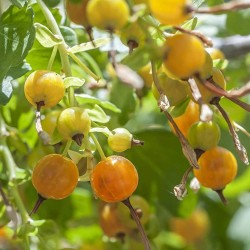
Golden Currant Seeds (Ribes...
Price
€2.25
(SKU: V 129 G)
Seeds Gallery EU,
5/
5
<meta http-equiv="Content-Type" content="text/html; charset=UTF-8" />
<h2><strong>Golden Currant Seeds (Ribes Aureum)</strong></h2>
<h2><span style="color: #ff0000;"><strong>Price for Package of 10 seeds.</strong></span></h2>
<p>Grown for its clove-scented flowers and its edible berries, this small to medium-sized deciduous shrub from central and western North America makes an excellent subject for the ornamental or culinary garden. Its showy drooping clusters of small, five-lobed, bright yellow flowers appear in mid- to late spring, and are visited by hummingbirds. Small, tart, juicy, several-seeded "currants" follow, ripening to black or yellow in mid- or late summer. The smooth, light green, three-lobed leaves turn purplish tones in fall. The former Ribes odoratum is now considered to belong under Ribes aureum as variety villosum.</p>
<p>This tough and adaptable shrub does well in a wide range of soils in full to partial sun. It needs some winter chill to perform well. Use it in mixed borders, edible plantings, and hedges.</p>
<p> </p>
<p><strong>Genus</strong> - Ribes<br /><strong>Species</strong> - Aureum<br /><strong>Common name</strong> - Golden Currant<br /><strong>Other names</strong> - Ribes teniuflorum, Buffalo currant, Missouri current<br /><strong>Germination rate</strong> - 80%<br /><strong>Pre-Treatment</strong> - Required<br /><strong>Germination info</strong> - Cold/moist stratification for 120 days<br /><strong>Hardiness zones</strong> - 3 - 7<br /><strong>Height</strong> - 3'-6' / 0.9m - 1.8m<br /><strong>Spread</strong> - 3'-6' / 0.9m - 1.8m<br /><strong>Plant type</strong> - Shrub<br /><strong>Vegetation type</strong> - Deciduous<br /><strong>Exposure</strong> - Full Sun, Partial Sun, Partial Shade<br /><strong>Soil PH</strong> - Acidic, Neutral, Alkaline<br /><strong>Soil type</strong> - Clay, laom, Sand, well drained<br /><strong>Water requirements</strong> - Average Water<br /><strong>Landscape uses</strong> - Edible, Fruit / Fruit Tree, Hedges, Mixed Border, Wildflower<br /><strong>Leaf / Flower color</strong> - Green, Light Green / Yellow<br /><strong>Plant growth rate</strong> - Medium</p>
V 129 G (10 S)


Plant resistant to cold and frost
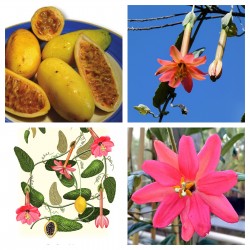
Passiflora adulterina Seeds
Price
€4.85
(SKU: V 22 PAS)
Seeds Gallery EU,
5/
5
<h2><strong>Passiflora adulterina Seeds</strong></h2>
<h2><span style="color: #ff0808;"><strong>Price for Package of 5 seeds.</strong></span></h2>
<p>A rare Passiflora species was discovered in Colombia in 2015.<br />Evergreen perennial climber 5 m (up to 20 m in nature) with alternate, elliptic, deep green, veined leaves, and finely serrate leaf margins. The long, pendulous pink flowers appear in the leaf axils, followed by showy edible, and tasty fruits. It bears many fruits in the shape of papaya.</p>
<p>In winter, it usually loses the above-ground part, so in the spring, young shoots sprout again. It blooms from spring to autumn. It is stored outdoors from spring to autumn, and in a cool room in winter.</p>
<p>Winter hardy to -6C</p>
V 22 PAS (5 S)






